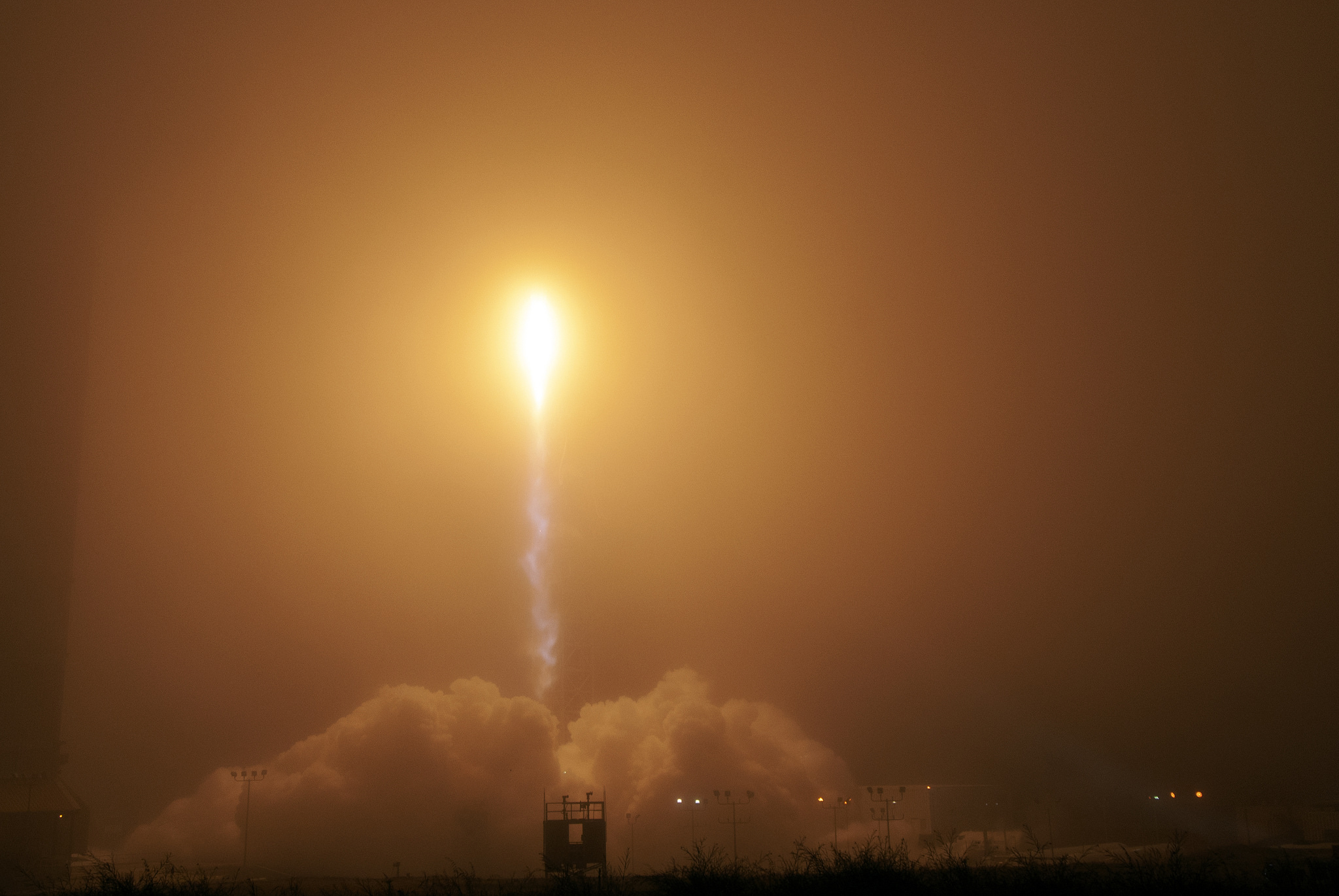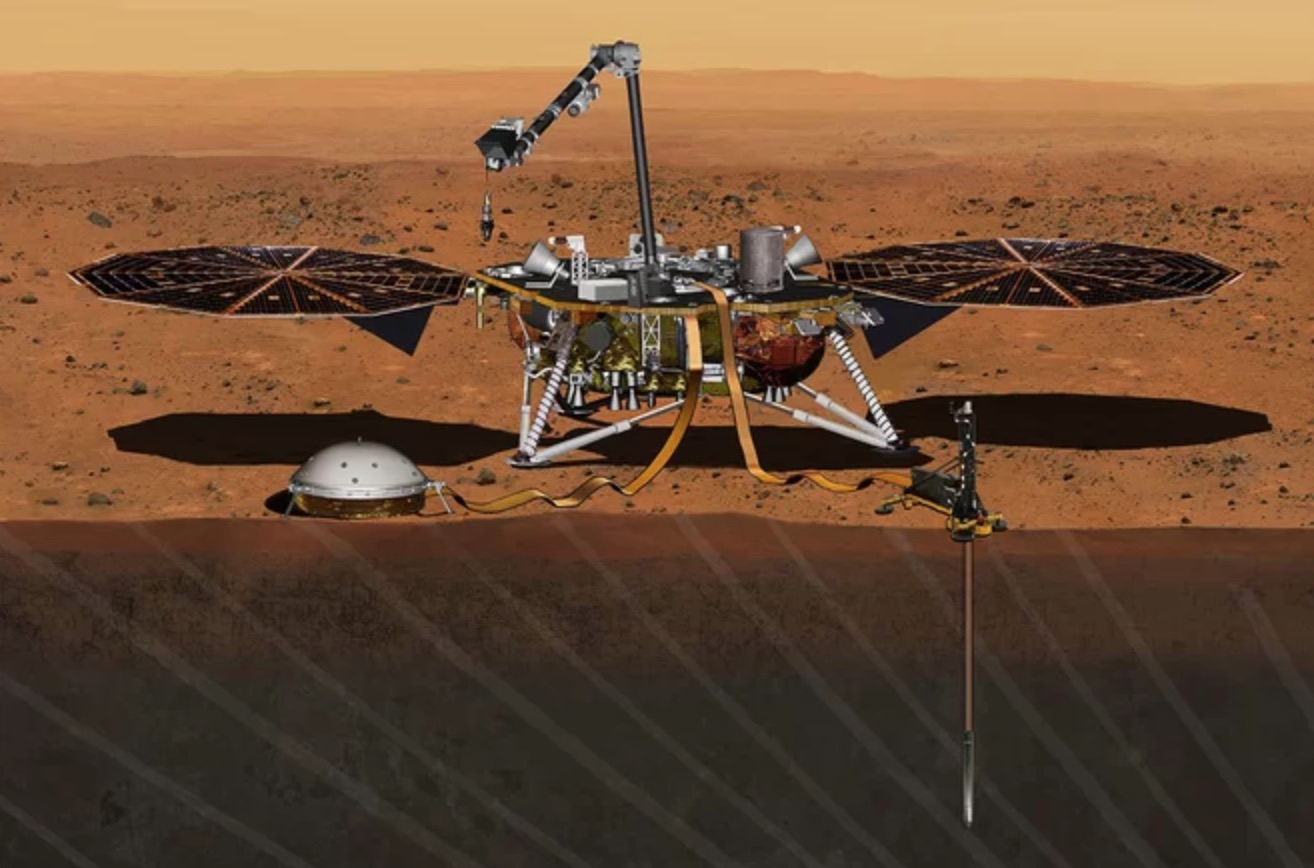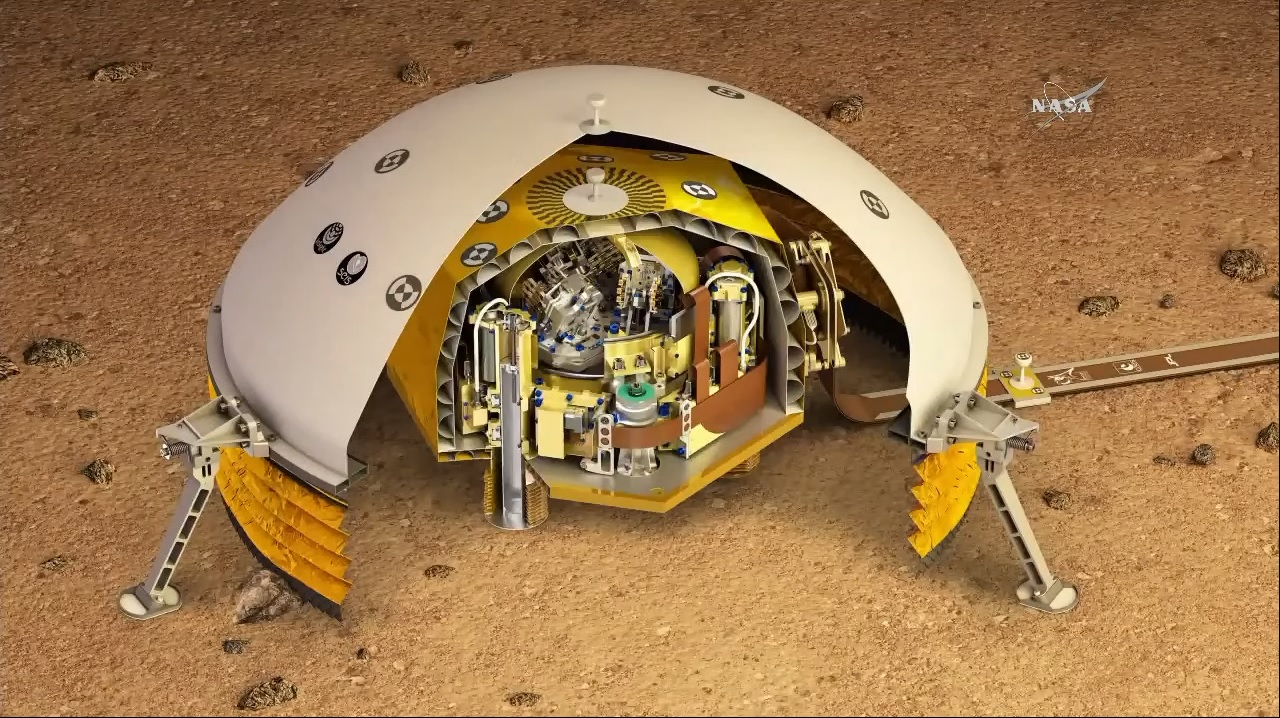NASA's InSight Mars Lander Launches to Probe Red Planet's Deep Interior
VANDENBERG AIR FORCE BASE, Calif. — NASA's latest Mars explorer is on its way to the Red Planet.
The agency's InSight Mars lander lifted off today (May 5) atop a United Launch Alliance Atlas V rocket, rising off a pad here at 7:05 a.m. EDT (1105 GMT, 4:05 a.m. local California time) and disappearing into the thick predawn fog moments later.
"This is a big day. We're going back to Mars," NASA's new administrator Jim Bridenstine, who took charge of the agency last month, said in a congratulatory call to the InSight team after launch. "This is an extraordinary mission with a whole host of firsts." [Launch Photos: See NASA's InSight Soar Toward Mars]
InSight is the first interplanetary mission ever to launch from the West Coast and NASA's first Mars surface craft to lift off since the Curiosity rover started its deep-space journey in November 2011.

If everything goes according to plan, InSight will reach its destination in a little less than seven months, touching down Nov. 26 on a nice, flat plain just north of the Martian equator. After a series of checkouts, the stationary lander will then begin a mission unlike any ever undertaken in the annals of planetary exploration.
InSight "will probe the interior of another terrestrial planet, giving us an idea of the size of the core, the mantle, the crust — and our ability then to compare that with the Earth," NASA Chief Scientist Jim Green said during a prelaunch news conference on Thursday (May 3). "This is of fundamental importance for us to understand the origin of our solar system and how it became the way it is today."
Two briefcase-size satellites also hitched a ride on this morning's launch and will make their own way to Mars, in an attempt to become the first-ever interplanetary "cubesats." The probe is also carrying a chip with 2.4 million names from space fans, including "Star Trek's" Captain Kirk William Shatner, who signed up to send their names to Mars.
Get the Space.com Newsletter
Breaking space news, the latest updates on rocket launches, skywatching events and more!
Taking Mars' vital signs
NASA officials have compared InSight — whose name is short for Interior Exploration using Seismic Investigations, Geodesy and Heat Transport — to a doctor performing a long-overdue checkup. [NASA's InSight Mars Lander: 10 Wild Facts]
For example, the solar-powered lander will take Mars' temperature using a heat probe that will hammer itself about 16 feet (4.9 meters) beneath the red dirt. And InSight will monitor the planet's pulse, detecting vibrations caused by "marsquakes," meteorite strikes and other events, all using an ultraprecise seismometer called the Seismic Experiment for Interior Structure (SEIS).
"Ultraprecise" is no exaggeration: SEIS will be capable of spotting vibrations smaller than a hydrogen atom, mission team members have said. The instrument must therefore be encased in a vacuum chamber, so its observations aren't swamped by environmental noise.

InSight will place SEIS directly on the ground using the lander's robotic arm, and then place a shield over SEIS to block wind and dampen temperature variations. That's another first that this mission will achieve: Other Mars robots have generally kept their scientific gear close, and none have deployed an instrument using their arms in this way.
"It's a first-time event, so we're always concerned about that," Chuck Scott, InSight flight system manager at NASA's Jet Propulsion Laboratory (JPL) in Pasadena, California, told Space.com.
But the InSight team has done "an extreme amount of testing" here on Earth to prepare for the milestone deployment, Scott added, so the team isn't unduly worried.
SEIS and the heat probe — which is known as the Heat Flow and Physical Properties Package (HP3) — are InSight's main scientific instruments. But the mission will perform another experiment using the lander's communications gear.

During this investigation, known as the Rotation and Interior Structure Experiment (RISE), scientists will track InSight's location precisely — to within 1 foot (0.3 m). This work will allow team members to detect tiny wobbles in Mars' axis of rotation, which should reveal key insights about the planet's core, including its size.
Analysis of the HP3 and SEIS data will also shed light on Mars' interior, including the thickness of the planet's crust and the structure and dynamics of Mars' mantle. Taken together, this information will help researchers better understand how rocky planets form and evolve, mission team members have said.
We can't look to our own planet for such information, because Earth's roiling insides have erased the evidence of what happened long ago. The long-dead moon does preserve such evidence, but our natural satellite is so much smaller than Earth that the processes that occurred inside each world in the ancient past are very different, said InSight principal investigator Bruce Banerdt, of JPL. [InSight in Pictures: NASA's Mission to Probe Mars's Core]
"So, Mars is kind of a unique opportunity. We call it the Goldilocks planet — it's not too big, it's not too small, it's just right," Banerdt said during Thursday's news conference.
"It's actually undergone the processes of planetary differentiation that the Earth did," he added. "But about maybe 20 [million] to 50 million years after it was formed, it just kind of stopped. We have lots of geology going on on the surface, but all those fingerprints of those early processes are still retained in the deep interior. And so, that's why we want to go measure the fundamental parameters of the deep interior."
The mission's data could also be a boon to future human exploration on Mars, Green said. "How quake-prone is Mars? That's fundamental information that we need to know as humans then explore Mars," he said. [How Will a Human Mars Base Work? NASA's Vision in Images]
The HP3 data may also reveal temperature differentials that humans could harness to heat habitats, Green added.
"This mission does so many fundamental things, not only in planetary science but in human exploration," he said.
A two-year delay
InSight was originally supposed to launch in March 2016. In advance of that date, NASA and the mission team decided to launch from here, on the central California coast, rather than the usual site for interplanetary missions, Cape Canaveral Air Force Station in Florida.
Launching from the East Coast offers a distinct advantage for such missions: Rockets get an extra push from Earth's rotation, which is going in the "right" direction. But Cape Canaveral was forecast to be pretty busy in early 2016, and the InSight team wanted to avoid congestion. So, they picked Vandenberg. And InSight is light enough, and the Atlas V powerful enough, to overcome the Earth-rotation issue, mission team members said.
The launch-site decision held even after InSight failed to hit the original window. In late 2015, the mission team detected a tiny leak in SEIS' vacuum chamber — so tiny that it would take 50 years to lower the pressure by 1 lb. per square inch in a car tire, Banerdt said.
But SEIS' need for precision is so great that the team had to fix the leak. And they couldn't do so properly before the 2016 launch window ended, so InSight's liftoff was pushed back more than two years. (Mars and Earth align favorably for interplanetary missions just once every 26 months.)
The fix and the delay added $154 million to the mission's price tag, NASA officials said in 2016. U.S. investment in the mission is now $814 million, with about $163 million of that total going to launch services, according to NASA officials.
France and Germany have contributed an additional $180 million, mostly to develop SEIS and HP3. The French space agency, CNES, provided SEIS for the mission, and the German space agency, DLR, built HP3.
NASA and JPL ponied up another $18.5 million for those two cubesats. The duo are officially known as MarCO-A and MarCO-B ("MarCO" being short for "Mars Cube One"), but their developers have dubbed them Wall-E and Eva. That's because the cubesats' propulsion system uses compressed R236FA gas, which is the propellant in many fire extinguishers — and in the 2008 movie "Wall-E," the eponymous, trash-compacting robot famously used a fire extinguisher to zoom around space. (Eva was Wall-E's friend in the film.)
Wall-E and Eva (the cubesats) are tasked with a demonstration mission: to show that cubesats, which to date have stuck close to Earth, can journey to other planets. The plan calls for the two tiny satellites to fly by Mars as InSight arrives for its crucial entry, descent and landing (EDL) sequence. Wall-E and Eva will attempt to beam EDL data from the lander back to controllers here on Earth, but it won't be a disaster for InSight if the cubesats fail to pull it off. NASA's Mars Reconnaissance Orbiter will perform the relay work regardless. [Latest Photos from NASA's Mars Reconnaissance Orbiter]
MarCO team members will assess the health of Wall-E and Eva within a few weeks of the Mars flyby, and that will be the end of the cubesats' mission.
InSight, of course, will just be getting started at that point; the lander's prime science mission is designed to last until Nov. 24, 2020.
Mars is still hard
The main body of the 790-lb. (358 kilograms) InSight is based heavily off NASA's Phoenix lander, which landed near the Martian north pole in May 2008 (and found water ice just beneath the surface shortly thereafter). InSight will also employ Phoenix's landing technique, relying on parachutes and engine firings to slow itself enough for a soft and safe touchdown on the Red Planet (as opposed to the much heavier Curiosity, which also used parachutes but was lowered to the surface on cables by a rocket-powered "sky crane").
And InSight's avionics and other electronics borrow from the agency's Mars Atmosphere and Volatile Evolution (MAVEN) orbiter, which has been circling the Red Planet since September 2014.
Leveraging such heritage hardware is a way to save money and reduce risk. And Mars missions are still risky, despite the lengthy run of success that NASA has enjoyed at the Red Planet recently. That active six-mission streak of safe arrivals runs from the Mars Odyssey orbiter, which reached the Red Planet in October 2001, through MAVEN's orbital insertion.
"Mars is hard," said Tim Linn, InSight deputy program manager and EDL manager at aerospace company Lockheed Martin, which built the spacecraft for NASA.
"It's one of the neatest things we do, but it's still really hard," Linn told Space.com.
Follow Mike Wall on Twitter @michaeldwall and Google+. Follow us @Spacedotcom, Facebook or Google+. Originally published on Space.com.
Join our Space Forums to keep talking space on the latest missions, night sky and more! And if you have a news tip, correction or comment, let us know at: community@space.com.

Michael Wall is a Senior Space Writer with Space.com and joined the team in 2010. He primarily covers exoplanets, spaceflight and military space, but has been known to dabble in the space art beat. His book about the search for alien life, "Out There," was published on Nov. 13, 2018. Before becoming a science writer, Michael worked as a herpetologist and wildlife biologist. He has a Ph.D. in evolutionary biology from the University of Sydney, Australia, a bachelor's degree from the University of Arizona, and a graduate certificate in science writing from the University of California, Santa Cruz. To find out what his latest project is, you can follow Michael on Twitter.









